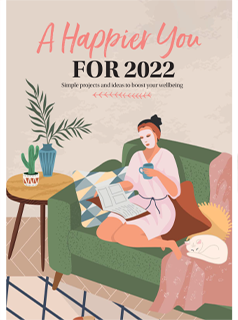Women’s health expert Marilyn Glenville explains how to keep healthy down below!
Women’s health expert Marilyn Glenville explains how to keep healthy down below!holistic guide from women’s health holistic expert Marilyn Glenville
Problem 1
Thrush
Your body contains billions of different organisms, most of them essential to health, and many perfectly harmless. One of these organisms is the fungus candida albicans, which in a healthy body is kept in check by billions of beneficial bacteria.
However, if an imbalance occurs, in particular in the body’s natural acid–alkaline balance, levels of beneficial bacteria fall and candida albicans begin to thrive and cause the yeast infection –thrush.
Tell-tale signs:
The most obvious sign that you have a yeast infection is a sticky, white discharge from your vagina, not associated with your usual menstrual cycle (its yeasty smell will give it away). Itching and soreness may occur during lovemaking or when you are urinating.
Diet dos and don’ts
Try to cut out sugar in all its forms as it is food for yeasts and bacteria and a diet that is high in sugar can only hamper your body’s attempts to overcome an infection.
A good food to eat if you suffer from a yeast infection is organic, live plain yoghurt (also calledbio-yoghurt). Live yoghurt is an important source of beneficial bacteria that can help overcome yeast overgrowth.
Reduce the risk:
Try applying live yoghurt topically to your vagina too, if you like.
Adding a handful of sea salt to your bathwater can help soothe irritation and itching in and around the vagina.
Only wear natural fibres, such as cotton and avoid wearing nylon tights as much as you can.
Herbal help:
Make up a combined tincture using equal parts of the herbs echinacea, goldenseal and pau d’arco.
Take one teaspoon in a little water, two or three times daily.
Problem 2
Vaginal infections
Your vagina is a warm, moist environment,and a perfect breeding ground for unwanted invaders. Vaginal infections result when the protective mechanisms malfunction.
Bacterial vaginosis (BV) is caused by an overgrowth of ‘unhealthy’ bacteria within the vagina itself. Unprotected sex, havingmultiple sexual partners, using an intrauterine device (IUD) for birth control,douching and using vaginal deodorants are all ways in which you can upset the acid-alkaline balance in your vagina.
The tell-tale signs
BV may show no symptoms at all, although some women do experience a greyish or yellow discharge that may also have a foul,fishy smell. You may find that the discharge is more noticeable after sexual intercourse.Sex may become painful and you coul dhave a slight burning sensation. If you have any symptoms you should visit your GP,especially if you’re trying for a baby as it can cause miscarriage.
Diet dos and donts
Eating a healthy diet (organic, alkalising foods such as lemon and fresh veg) will help to keep you body’s acid-alkaline balance in check. Try to eat more plain, live yoghurt. Avoid anything that contains sugar, which encourages unhealthy bacteria to grow.Yellow, orange and red fruits and veg are beneficial as they contain beta-carotenes which the body uses converts to vitamin A,which fights off infection.
Herbs to try:
The tinctures barberry root bark, echinacea,myrrh resin and marigold, will help the body attack bacteria. Combine in equal measures and put one teaspoon in water three times a day until the infection has gone.
Eat live plain yoghurt to recolonise your system with good flora
Problem 3
Cystitis
Our urinary anatomy is much more compact than a man’s. The female urethra (the tube from the bladder through which you pass urine) is considerably shorter and much closer to the anus. This makes it much easier for bacteria to pass into the woman’s bladder, causing an infection that inflames the bladder lining. You can also develop non-bacterial cystitis through a lot of lovemaking, which bruises the bladder.Irritants, including soaps and bubble baths;vibrations from riding a horse or motorcycle;spicy foods, caffeine and alcohol; dehydration;and chlorine in swimming pools can all also cause non-infectious cystitis.
Tell-tale signs
Symptoms include feeling a frequent, urgent need to go to the toilet, even if there’s very little urine actually inside the bladder itself. What urine you do pass usually stings the sore and inflamed lining of your urethra on its way out. In severe cases of cystitis, your urine may be tinged with blood. You may also feel nauseous,headachy or feverish and have lower abdominal pain.
Diets dos and donts
Acidic foods and drinks, such as tea,coffee, alcohol, sugar, meat, spicy foods and undiluted citrus juices, can trigger cystitis. Drink barley water as it works as an anti-inflammatory.
Eat live plain yoghurt to recolonise your system with good flora. Drink cranberry juice, as long as it’s unsweetened, unpasteurised and wholly natural. Cranberry juice will help to overcome cystitis because cranberries are high in substances called proanthocyanidins. These prevent the E.coli bacteria from attaching themselves to the mucus lining of the bladder and urethra. Garlic also helps to eliminate E.coli.Raw garlic is much more effective than cooked,so chop it finely and sprinkle it over salads or into dressings – or eat whole cloves if you can!
Reduce the risk:
Try aromatherapy: Dilute 15 drops of sandalwood essential oil in six teaspoons of warmed sweet apricot oil, place a few drops on your hands and massage your abdomen. You can try two drops of tea tree essential oils to your bath and bathe in the infused water for 20 minutes each evening.
Make sure you go when you need to go as holding on to your urine puts a strain on your bladder, worsening a bout of cystitis.
Showers are much more hygienic form of washing than a bath. So, if you’re prone to cystitis, opt for showering rather than bathing
Problem 4
Stress incontinence
Stress incontinence is a common condition,and it is caused by a variety of factors. Many women first experience stress incontinence during pregnancy, when the weight of the baby presses down on the pelvic floor,weakening bladder control. Following the birth, the pelvic floor muscles can be weakened so that normal control is not resumed for several months (or even years),unless exercises are regularly practised. During the menopause and beyond, stress incontinence becomes more common, as reduced oestrogen levels often lead to lower muscular pressure around the urethra,increasing chances of leakage.
Tell-tale signs
Common symptoms of stress incontinence include leaking when you cough, laugh or sneeze. It can also occur when exercising o rlifting, having little warning of the need to pass water, which means that you may not reach the toilet in time, and occasionally an increased urgency or need to pass water.Some women may find that they dribble urine without even realising it.
Reduce the risk
Make a note of how many times you need to go the toilet, when you need to go, and how often you have leaked. Then compare this against the amount of fluid you have taken.Try varying your fluid intake to see if it makes a difference. For example, the number of times you get up in the night to urinate may depend on how late you drink water, so make a note.
Pelvic floor exercises are an excellent way to tighten up the floor of your pelvis and many women experience complete relief of symptoms after several months of regular practice. Exercise your pelvis daily to prevent the condition from deteriorating,
Natural Health loves…
Bio-Kult Pro-Cyan, £14.95 – With two probiotic strains, vitamin A and cranberry extract these supplements work with your body to help maintain a healthy gut and urinary tract.
Article by
Dr Marilyn Glenville
Nutritionist
is a nutritionist specialising in women’s health. Visit marilynglenville.com
Discover more
Article by
Dr Marilyn Glenville
Nutritionist
is a nutritionist specialising in women’s health. Visit marilynglenville.com
Discover more


 By Dr Marilyn Glenville
By Dr Marilyn Glenville 




















